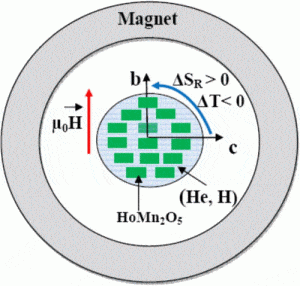The recent discovery of a new magnetocaloric material with intriguing characteristics could lead to a greener method of cooling, potentially providing a more environmentally-friendly alternative to standard refrigeration.
A joint team of researchers from Canada and Bulgaria have developed a new method of green cooling by identifying a multiferroic compound, HoMn2O5, that could act as the refrigerant in magnetic refrigerators through a phenomenon known as the magnetocaloric effect. The article detailing the research, “Anisotropy-Enhanced Giant Reversible Rotating Magnetocaloric Effect in HoMn2O5 Single Crystals,” was recently published in Applied Physics Letters.
Mohamed Balli, Ph.D., one of the study’s lead researchers at Quebec’s Université de Sherbrooke, describes the magnetocaloric effect as “the thermal response of a magnetic material to the change of an external magnetic field, which manifests as a change in its temperature.”

The scientists already knew, based on previous research, that ferromagnetic materials heat up when exposed to a magnetic field, and cool down when the magnetic field is removed.
“The presence of a magnetic field makes ferromagnetic materials become more ordered. This is accompanied by disorder within the atomic lattice, which causes an increase in the material’s temperature,” Balli explained. “Inversely, the absence of a magnetic field means that the atomic lattice is more ordered and results in a temperature decrease. Magnetic refrigeration essentially works by recapturing produced cooling energy via a heat transfer fluid, such as water.”
The team began studying HoMn2O5with the intention of researching further its electrical insulating properties, thought to be enabled by changes in its magnetic field.
However, they discovered that HoMn2O5 exhibited huge magnetocaloric effects by being rotated within a magnetic field – a significant breakthrough, as other magnetocaloric materials yielded effects only through manipulation in and out of the magnetic field zone.
“Using the rotating magnetocaloric effect means that the energy absorbed by the cooling machine can be largely reduced,” Balli said. “It also opens the door to building simplified, efficient, and compact magnetic cooling systems in the future.”
The burgeoning study of magnetic refrigeration has garnered excitement in the scientific community for its possibilities of providing a greener alternative to fluid-compression refrigeration, consuming less energy while requiring no hazardous fluids to operate effectively.
Engineers at GE recently developed a prototype for a magnetic refrigerator, operating via a water-based fluid that flows through a series of magnets arranged in a cascade to transfer heat. This technology, along with Balli’s recent research, will hopefully help lead to a widely-accessible green refrigeration option for consumers.
“This technology represents a step-change in the efficiency of refrigerator appliances and will significantly reduce electricity demand when it is widely adopted,” a spokesperson for GE said in a press release. “These refrigerators also completely avoid using ozone-depleting chemicals like halocarbons that also contribute to climate change.”
“We will likely see the technology spread into other domains that require cooling, such as air conditioning, thermal management of electronics, industrial process cooling, and liquefaction of natural gas. If successful this technology will make a measureable improvement in the sustainability of our energy supply and contribute to the effort to reduce climate change.”
– Melanie Abeygunawardana




